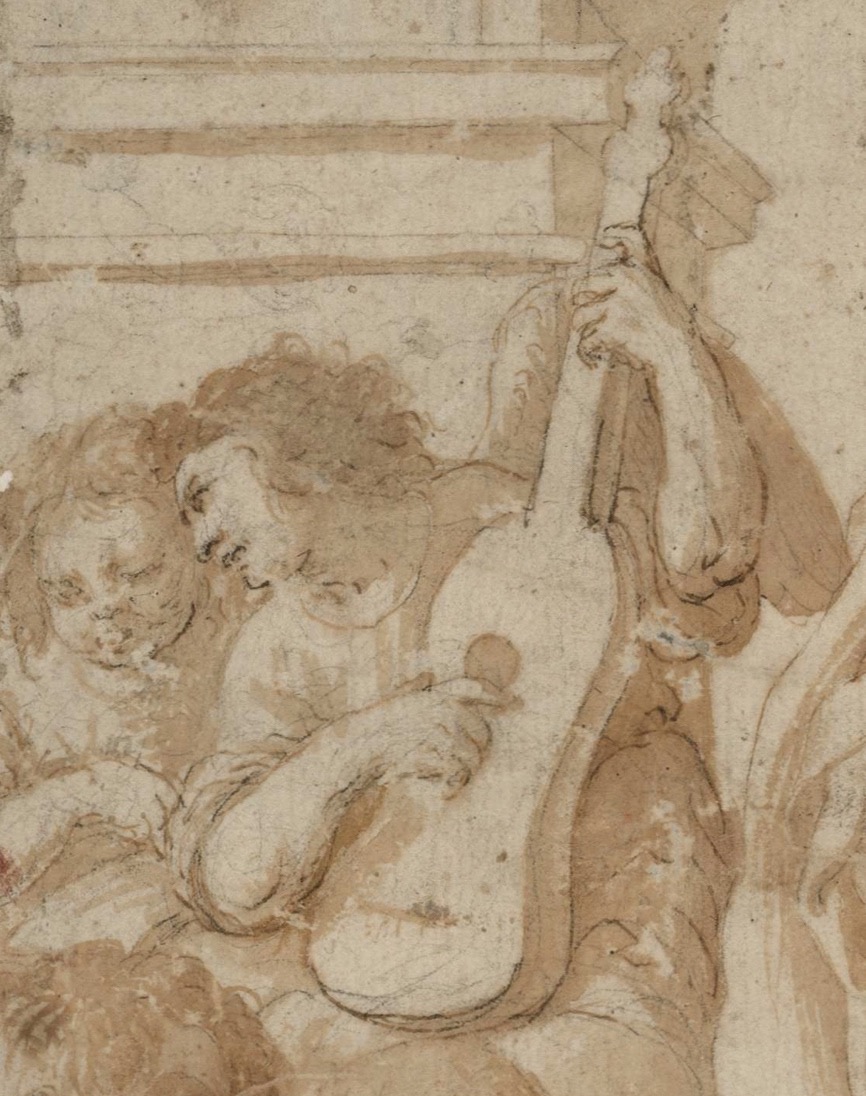Angel Guitarrist. drawing of for Porta Coeli altarpiece. Juan Ribalta. c.1622
(1622) - E-Mn Madrid, Biblioteca Nacional.
instrument: vihuela de mano / guitarra | century: 17cent/1/early | catalogue nº: 17-133

Artwork
Creator Ribalta, Juan
Medium Artwork: Drawing
Location
City Valencia | Region Valencia | Old kingdom Aragon
Characteristics
| Body Waisted | Strings None | Neck Long | Pegbox Flat leaf |
| Bridge Fixed | Frets No | Back Flat | Pegs Unclear |
| Technique Plucked fingers equal p+i |
Commentary
ARTWORK
Virgin and Child surrounded by Angels. Drawing of the altarpiece painting “Virgen of Portacaeli” for the Carthusian Monastery of Porta Coeli in Serra (comarca de Tiuria, Valencia) painted by Juan Ribalta between 1625 and 1627.
The catalogue entry of the E-Mn classifies the work as anonymous, either by someone from the Ribalta workshop, or either Francisco Ribalta (1565-1628) or his son Juan Ribalta (1596-1628). The drawing is described as a drawing on yellow laid paper using brush, pencil, black pencil, ink and brown gouache. Size = 414 x 301 mm. It has a handwritten pencil inscription, on the lower edge, in modern script: "Ribalta". The drawing is dated 1600-1629.
Angulo, D. y Pérez Sánchez, A.E. Corpus of Spanish drawings. 1988 v. IV, n. 377 date the work as 1622-1626
Barcia, Catalogue drawings BN. (1906) 453 and p. [863] includes it among the works of Juan Ribalta, but later modifies its attribution (p. [863]) to Francisco Ribalta
Benito Domenech, Fernando. The Ribaltas and Valencian painting of their time. 1987 believes that this is a later copy of the painting by Francisco Ribalta and his collaborators. Considered a copy of the painting of the Porta-Coeli altarpiece, made in Ribalta's workshop (Museo BB.AA. de Valencia), according to Angulo and Pérez Sánchez (1988) who include it among the works of Juan Ribaltap. (pp.186 -187).
INSTRUMENT
The instrument has a large sized body consistent with a guitar of the early 17th century, with fixed bridge and round sound hole. The only feature that links it more to 16th-century vihuelas is the thin body (even thinner in the painting (➞17-134). Given its size, it is more likely to be a guitar.
Reproductions
http://bdh-rd.bne.es/viewer.vm?id=0000066394&page=1